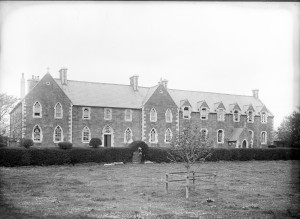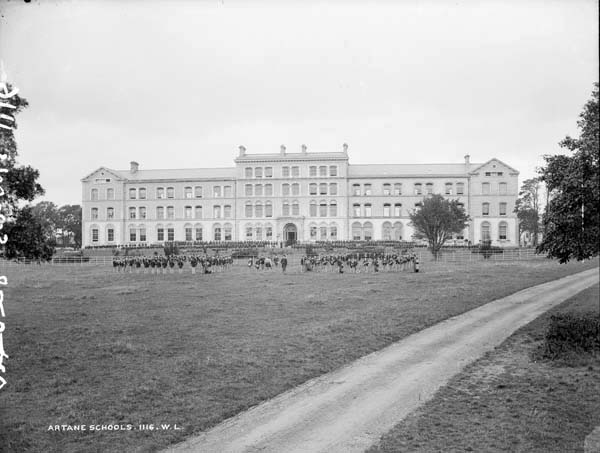In 1999, RTÉ, Ireland’s public service broadcaster, aired journalist Mary Rafferty’s three-part special, States of Fear. The exposé included interviews with survivors of Ireland’s industrial schools, state-funded Catholic institutions where poor and unwanted children were deposited for most of the twentieth century, and where many suffered physical, emotional, and sexual abuse. The series shocked Ireland, drawing such an intense public response that, before the final episode aired, Taoiseach (Prime Minister) Bertie Ahern issued an official apology on behalf of the Irish state for failing to intervene. The next year the government established an inquiry into the alleged abuses, led by High Court Justice Seán Ryan.

Catholic lay orders, mostly Christian Brothers, ran the industrial schools. They were pitiful institutions: teachers poorly trained, facilities badly kempt, resources ineffectively used. The “Ryan Report” revealed that children had complained to parents, police, and others about their treatment to no avail and were instead ignored or punished for speaking up. It was their word against the word of the adults, the doers of God’s work on Earth.
States of Fear, however, came at the end of a decade of scandals involving the Catholic Church and abuses of power, making it of greater interest to its Irish audience. The 1990s had begun with the exposure of priests like Michel Cleary and Brendan Smyth who had terrorized the people who looked to them for leadership and spiritual guidance. The Ryan Commission called many of these perpetrators to court to answer for their crimes. Ireland finally spoke out decisively against the sexual abuse of children.
But that’s not the whole story. The Irish state had intervened in the actual and perceived sexual abuse of children—but selectively, failing to step in on those cases involving the Catholic Church and its institutions. Same-sex desiring men outside of the Catholic Church had been arrested since the early twentieth century under Ireland’s gross indecency laws. More often than not the justification for clearing them off the streets was to protect children, regardless of whether or not the cases involved children. For example, in February 1931, Judge Cahir Davitt presided over a case regarding a “male brothel.” Police observed James Hand for a year, during which it became clear that he invited young men, aged 17-21, to his house where he left them with Frank North who paid the “boys” for sex. Newspapers like the Irish Times portrayed Hand as a corrupter of children and a menace to Irish society. In one report on the case, Judge Davitt explained that “the offence … was a disgusting one, and one which, unfortunately, seemed to be spreading in the city. … if allowed to develop and go unchecked, [it] would become—if, indeed, it had already not become—a lasting worry to the parents of young boys.” Though there were no children (legally defined as under the age of 14) involved in the Hand case, Davitt—like many of his contemporaries, in Ireland, but also in the U.S., the United Kingdom, and elsewhere—often conflated male same-sex desire with pedophilia, and considered young men aged 17-21 “children” when involved in same-sex sex crimes.
Davitt conveyed a concern shared by many. After Ireland achieved independence in 1922, the policing of male same-sex sexual activity increased as the new Irish state sought to assert itself as more moral than its former British rulers. Between 1922 and 1965 the arrests of adult men for sex with boys under 17 accounted for only one-third of all arrests for the sexual assaults of children. By and large, gross indecency arrests were for the crime of sex between two consenting adults. Yet the language of the punishment for consenting adult men was couched in terms of protecting children.
How could the state be so outwardly concerned with child sexual abuse, arresting hundreds of men over the course of a few decades, but allow the abuses in state-funded institutions to continue unchecked? The answer is telling about twentieth-century independent Ireland: the average same-sex desiring man stood powerless in this new state, while the Irish Catholic Church, on the other hand, remained untouchable.
The Catholic Church, in the words of the 1937 Constitution, held a “special place” in independent Ireland, a compromise made by Irish president Eamon de Valera instead of declaring the Catholic Church the official state church of Èire. By enshrining the Church as special above other religious institutions, the state acknowledged the significance of the Church in the lives of Irish men and women without giving it actual state-endowed powers.
Though non-Catholics had always lived in Ireland, Catholic culture permeated society. And the centrality of the Church gave it particular power, so that even the state left it largely unmonitored—or, was reluctant to face off against the Church, as long as the Church held sway over Ireland.

Historians disagree, however, over when the Church began to lose its power in Ireland. Many historians point to 1950 when Church officials blocked a popular health care bill to provide medical care to mothers and their children. Yet in that debacle Prime Minister John Costello famously announced he was “Catholic first and an Irishman second,” reifying the power of the Church far more than challenging it. In that clash between Church and state, some elected officials protested the Catholic hierarchy overstepping its place, but the Church’s power held.
Nor did stories of abuses within the Catholic institutions break the Church’s hold on Ireland. If knowledge of the physical, emotional, and sexual abuse of children by priests and Catholic laypeople had been all it took to overturn Catholic dominance, then Ireland would’ve turned from the Church decades earlier. Child abuse was less secret than anyone would ever like to admit. The Ryan Commission found that community members and school employees overlooked the abuses, uncovered police departments that ignored complaints, and even discovered some instances of investigation by Church officials that resulted in the transfer of abusers and the suppression of the victims’ experiences. These moments of revelation did not break the Church’s hold on Ireland. Rather, the Church’s power had to erode before Ireland could be scandalized by the abuses that characterized life in those institutions.
These scandals emerged in the period of Ireland’s economic turnaround (1990s-2000s). The nation’s newfound economic strength helped undercut the Church’s power as affluence eroded Irish dependence on Catholicism for spiritual and personal sustenance. In the era of the mighty Celtic Tiger, money and materialism subsumed penitence and prayer. From 1973 to 2011, weekly Mass attendance plummeted in Ireland as GDP rose. At the same time, this economic boom meant highly-educated, less-religious Irish who had long emigrated from their native country now remained along with a growing cosmopolitan foreign population immigrating to Ireland. In the context of weakening religiosity, declining church attendance, and changing national demographics, the Irish people began to challenge the rigid social order enforced for so long by the Catholic Church, thereby allowing them to finally see and acknowledge the decades of abuse perpetrated by the Church. Controversial issues like the legalization of birth control and divorce, the decriminalization of homosexuality in 1993, the passage by Irish voters of the marriage equality referendum in 2015, and even the tense but civil discussions of abortion rights that have emerged in recent years found their possibility in Ireland’s however brief economic success.
Abuse scandals rooted in Catholic institutions all over the world broke in the 1990s and early 2000s. For the most part, scandals centered on a single city, in places like the Mount Cashel Orphanage in St. John’s, Newfoundland, and the Catholic diocese of Boston, where those institutions were embedded in and trusted by the community. The Irish scandals, however, were widespread; the commission uncovered rampant abuse of children in over twenty-five institutions throughout the country. The persistence of these abuses required the acquiescence of the community and the state—which conducted “inspections” of the state-funded “schools”—to remain “undiscovered.” It also required the on-going silence of the victims, further evidence of the Church’s power in Ireland where a culture of guilt, shame, and fear stopped these victims from speaking out even when they reached adulthood. While police arrested men accused or suspected of the sexual assault of children, articulating the state’s official position on child sexual abuse, it exempted the Church from that same scrutiny for much of the twentieth century. But that exemption did not carry into the twenty-first century. Once the Irish people had a new point of reverence, they finally were willing and able to see that the sexual danger to their children lurked not in their streets, but rather in their churches.
 Averill Earls received her PhD in History from the University at Buffalo, where her dissertation examined the intersections of postcolonialism, gender, and sexuality in modern Irish history. She is the Executive Editor of The History Buffs Podcast, and one half of the team at DIG: History & Genealogy Consulting. When she’s not digging around in archives or working on myriad side projects, she likes to relax with her partner Dan and their puppy Curie.
Averill Earls received her PhD in History from the University at Buffalo, where her dissertation examined the intersections of postcolonialism, gender, and sexuality in modern Irish history. She is the Executive Editor of The History Buffs Podcast, and one half of the team at DIG: History & Genealogy Consulting. When she’s not digging around in archives or working on myriad side projects, she likes to relax with her partner Dan and their puppy Curie.

NOTCHES: (re)marks on the history of sexuality is licensed under a Creative Commons Attribution-NonCommercial-NoDerivatives 4.0 International License.
Based on a work at www.notchesblog.com.
For permission to publish any NOTCHES post in whole or in part please contact the editors at NotchesBlog@gmail.com




